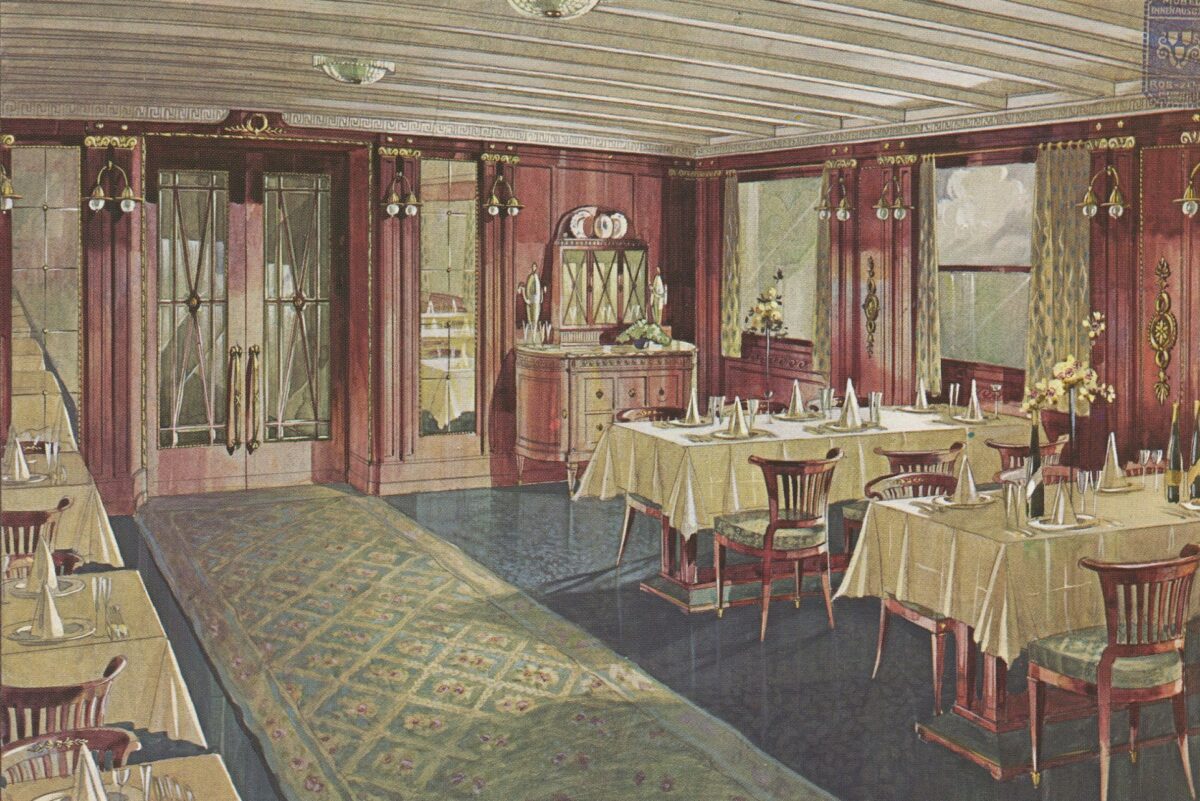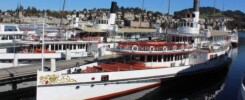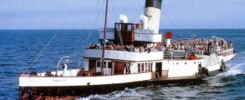
The huge industrial developments in Britain, Europe and America in the nineteenth century, and particularly from the 1850s onwards, spawned money on a scale never seen before. Europe was awash with it. Where once travelling on the Grand Tour had been the preserve only of the very rich now it became increasingly open to other previously excluded market segments. And whilst the poorest in Britain were not in that league, nonetheless even they were able to travel and take holidays in their own country by the seaside for the first time in history. In the late eighteenth century Mozart was writing for orchestras of generally about 30 players because that was all that could be afforded. By the time of the Belle Epoque in the run up to the First World War over a hundred years later Mahler was writing for orchestras of 100 players as cities around the world clamoured to spend their money on a vast canvas.
And so it was in Switzerland. To cope with the ever burgeoning demand between 1901 and the First World War the Lake Lucerne Steamship Company built no less than eleven vessels for the lake. There were the paddle steamers Uri (1901), Unterwalden (1902), Schiller (1906) and Wilhelm Tell (1907). Then in 1909 they picked up cheap the former Thames penny steamer Ben Johnson, shipped her over and rebuilt her for year round service on the lake under the name Rhein. In 1910 they added four smaller launches Astra, Aero, Mars and Neptun and in 1912 the Delphin, all propelled by the then very new fangled benzine or diesel motors.

Also in 1912 they were talking of needing another paddle steamer just like Schiller and Wilhelm Tell to meet the ever expanding market. The company approached Sulzer, which had built these two, but they were busy. So the order for what was to become the Gallia went to Escher Wyss. Work commenced on 29th November 1912 and continued apace through December 1912 and on into the spring of 1913.

Hindsight of course is a wonderful thing. And nobody planning for the tourism market when Gallia was ordered and delivered had any idea that the whole chimera was about to come crashing down with the world plunged into the chaos and the dire economic consequences of of the First World War from the autumn of 1914. Britain’s First Sea Lord Jackie Fisher had been a regular visitor to Lucerne and a traveller on the lake paddle steamers in the peaceful era of the Belle Epoque. Now he and most other potential tourists had other things to occupy their minds.

Like the other Swiss paddle steamers, Gallia was built to a high standard and had accommodation for both first and second class passengers. This picture of her first class dining saloon shows the fine panelling and decoration to be enjoyed by those who could afford the dinners.

Another issue today for these paddle steamers built with a dining salon capacity to accommodate only 10/15% of their passenger numbers is how to feed them if more than 10/15% want to be fed. And beautiful ship though she is Gallia can seat only around 80 in her dining saloon. As you can see in this picture she has some extra provision of seating for eating on the promenade deck protected by canvas dodgers but this low number of covers means that she is less well used on the lake than Stadt Luzern, Uri and Unterwalden which can each seat many more for lunch or dinner.

The rich and famous ever travelled on the Swiss paddle steamers. Here Captain Zimmermann has Lilian Harvey, a film star and famous actress from the 1920s and 1930s under his arm. Born in 1869 he was Gallia’s second master following Captain Joseph Imhof who had command from when the ship was built in 1913 through to 1922. Captain Zimmermann became a captain on the lake in 1906 and retired in the summer of 1932. Sadly he died only months later on 12th December in the same year.

The attention to detail is one of the very many things I love about Switzerland and the Swiss paddle steamers. The readiness with procedures in place for all potential difficulties. Here stowed just outboard of the railings are two poles, sometimes called dollies, for use when alongside another vessel where the sponsons or rubbing bands don’t easily match up and so prevent them catching.

Then there are the flags. They always take the flags down at night and/or when the ships are not running. I remember Cosens’s paddle steamers doing that in my youth and carried forward the tradition on KC. Why fly flags and wear them out when your passengers aren’t looking at them? Who is looking at, or can see, a flag at 3am in the morning? By definition if you fly them less often they will last longer and you won’t have to replace them as frequently. It is a little thing. It is a little cost saving. But every little helps and small savings add up over time.

Another cost saving has been in reducing crew numbers. Up to the 1970s the paddle steamers on Lake Lucerne sailed with a two man bridge watch including the helmsman and the captain. As new technologies developed, with for example electric hydraulic steering, management were keen to adopt them if that meant that a saving could be made in operational costs. Traditionally on Lake Lucerne for berthing the captain left the experienced helmsman to his own devices on the bridge and issued orders to the engineer through a voice pipe positioned at the forward end of the promenade deck either side. You can see him clearly in the picture above. However this system involved two people. Management wanted to move to just one with the captain doing his own steering as well as issuing the engine orders. There was resistance to this. Some of the older captains said that it couldn’t be done. On a paddle steamer you just had to have a captain and a helmsman. That was the way to do it. They knew best. However, the management thought differently. As a result some of the older captains retired. Others moved onto the motor ships and a new generation of younger captains came up quite willing to do both jobs themselves.

The thirty seven year old Captain Alois Kaufmann was given command of Gallia in 1984 replacing Captain Franz Baumgartner who had just reached the age of 65 and therefore retired. Two years later Captain Kaufmann was promoted to command the flagship of the fleet Stadt Luzern and the young Captain Jorg Andrist was given Gallia. Here he is on her starboard bridge wing with the control console which includes an electric engine room telegraph, jog switch for the electric steering and helm indicator to show the position of the rudder. He also has a traditional brass voice pipe so that he and the engineer can speak to each other. And that is a really important bit of kit. Handling a paddle steamer is a team effort between the captain, engineer and rope handlers. There must be a rapport between them. Each has to understand what each other is doing. And they need to communicate with each other and work as a team.

The engineers in Switzerland are all well trained in the art of handling a paddle steamer engine. All know the importance when manoeuvring of stopping the engine in just the right place to get it started again when coming into a pier. And that is crucial. I recall in the early days of running KC we sometimes had issues with the engine getting stuck and steam locked. I recall sailing past Thunderbolt Pier at Chatham with full astern on the telegraph and nothing happening. Fortunately it was not a dead end. And for sorting it out I am very grateful for what we learned about all this from the experts in Switzerland all those years ago.

Gallia is now 109 years old. That is a great age for ships which are generally built for a projected life span of about 25 to 30 years. After that it is expected that they will either be scrapped or they will need an extensive rebuild. The Swiss are meticulous keepers of recorders and I have here with me extensive details of Gallia’s career. For example I can tell you that in 1947 she was in service from January through to October during which she steamed 15,016Km. In 1985 she was in service between May and September and steamed 10,700Km. And so on, The records also detail what was done to her year on year throughout her career and from this it is clear that as well as other work going on from time to time, she has had several major rebuilds. The first of these is recorded in 1936/37. She was converted from coal to oil in 1952/53 at which time other structural work was undertaken. Then in 1977 she had another major rebuild. And in 2002/2003 she was out of service for another rebuild during which she was stripped back to nothing with deck and steelwork replacement as necessary.

So there we leave it for this month with Gallia sailing away from Brunnen on Lake Lucerne on a lovely day in August 2021 one hundred and eight years after she was built to take advantage of all that tourist money flowing into Lucerne in the Belle Epoque era.
Kingswear Castle returned to service in 2023 after the first part of a major rebuild which is designed to set her up for the next 25 years running on the River Dart. The Paddle Steamer Kingswear Castle Trust is now fund raising for the second phase of the rebuild. You can read more about the rebuilds and how you can help if you can here.
John Megoran


